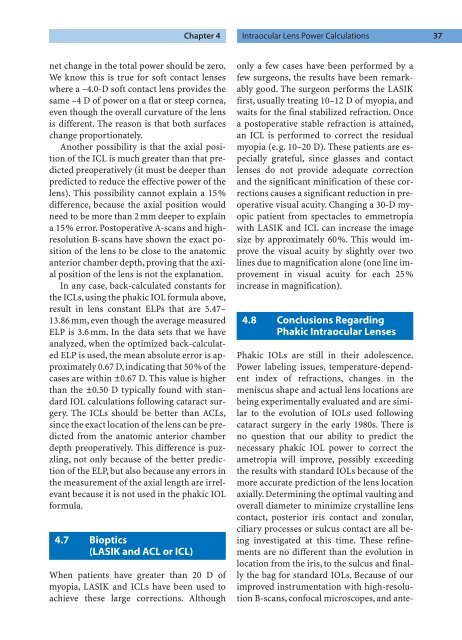Refractive Lens Surgery
Refractive Lens Surgery
Refractive Lens Surgery
You also want an ePaper? Increase the reach of your titles
YUMPU automatically turns print PDFs into web optimized ePapers that Google loves.
net change in the total power should be zero.<br />
We know this is true for soft contact lenses<br />
where a –4.0-D soft contact lens provides the<br />
same –4 D of power on a flat or steep cornea,<br />
even though the overall curvature of the lens<br />
is different. The reason is that both surfaces<br />
change proportionately.<br />
Another possibility is that the axial position<br />
of the ICL is much greater than that predicted<br />
preoperatively (it must be deeper than<br />
predicted to reduce the effective power of the<br />
lens). This possibility cannot explain a 15%<br />
difference, because the axial position would<br />
need to be more than 2 mm deeper to explain<br />
a 15% error. Postoperative A-scans and highresolution<br />
B-scans have shown the exact position<br />
of the lens to be close to the anatomic<br />
anterior chamber depth, proving that the axial<br />
position of the lens is not the explanation.<br />
In any case, back-calculated constants for<br />
the ICLs, using the phakic IOL formula above,<br />
result in lens constant ELPs that are 5.47–<br />
13.86 mm, even though the average measured<br />
ELP is 3.6 mm. In the data sets that we have<br />
analyzed, when the optimized back-calculated<br />
ELP is used, the mean absolute error is approximately<br />
0.67 D, indicating that 50% of the<br />
cases are within ±0.67 D. This value is higher<br />
than the ±0.50 D typically found with standard<br />
IOL calculations following cataract surgery.<br />
The ICLs should be better than ACLs,<br />
since the exact location of the lens can be predicted<br />
from the anatomic anterior chamber<br />
depth preoperatively. This difference is puzzling,<br />
not only because of the better prediction<br />
of the ELP, but also because any errors in<br />
the measurement of the axial length are irrelevant<br />
because it is not used in the phakic IOL<br />
formula.<br />
4.7 Bioptics<br />
(LASIK and ACL or ICL)<br />
When patients have greater than 20 D of<br />
myopia, LASIK and ICLs have been used to<br />
achieve these large corrections. Although<br />
Chapter 4 Intraocular <strong>Lens</strong> Power Calculations 37<br />
only a few cases have been performed by a<br />
few surgeons, the results have been remarkably<br />
good. The surgeon performs the LASIK<br />
first, usually treating 10–12 D of myopia, and<br />
waits for the final stabilized refraction. Once<br />
a postoperative stable refraction is attained,<br />
an ICL is performed to correct the residual<br />
myopia (e.g. 10–20 D). These patients are especially<br />
grateful, since glasses and contact<br />
lenses do not provide adequate correction<br />
and the significant minification of these corrections<br />
causes a significant reduction in preoperative<br />
visual acuity. Changing a 30-D myopic<br />
patient from spectacles to emmetropia<br />
with LASIK and ICL can increase the image<br />
size by approximately 60%. This would improve<br />
the visual acuity by slightly over two<br />
lines due to magnification alone (one line improvement<br />
in visual acuity for each 25%<br />
increase in magnification).<br />
4.8 Conclusions Regarding<br />
Phakic Intraocular <strong>Lens</strong>es<br />
Phakic IOLs are still in their adolescence.<br />
Power labeling issues, temperature-dependent<br />
index of refractions, changes in the<br />
meniscus shape and actual lens locations are<br />
being experimentally evaluated and are similar<br />
to the evolution of IOLs used following<br />
cataract surgery in the early 1980s. There is<br />
no question that our ability to predict the<br />
necessary phakic IOL power to correct the<br />
ametropia will improve, possibly exceeding<br />
the results with standard IOLs because of the<br />
more accurate prediction of the lens location<br />
axially. Determining the optimal vaulting and<br />
overall diameter to minimize crystalline lens<br />
contact, posterior iris contact and zonular,<br />
ciliary processes or sulcus contact are all being<br />
investigated at this time. These refinements<br />
are no different than the evolution in<br />
location from the iris, to the sulcus and finally<br />
the bag for standard IOLs. Because of our<br />
improved instrumentation with high-resolution<br />
B-scans, confocal microscopes, and ante-



